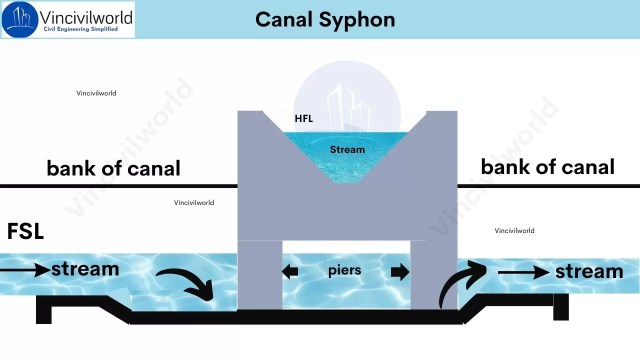Aqueduct is a cross drainage structure constructed to channel water from the rivers or stream to the distribution points. But modern engineering aqueducts is a cross drainage system constitute of pipes, ditches, canals, tunnels, and supporting structures constructed/laid to convey water from a source to the main distribution points. Aqueducts like syphon aqueduct and super passage play and important role in maintaining the strategic flow between drainage water with canal water.
Types of aqueduct play a vital role in effective water management, especially in irrigation systems where canals must cross drainage channels without mixing flows. Aqueducts are a primary category within the types of cross drainage works, structures designed to allow irrigation canals to pass over drainage waterways. Among these, the syphon aqueduct is a specialized type that uses enclosed, pressurized channels to handle crossings when water levels vary significantly. Understanding aqueducts and their function in irrigation is essential for managing water flow efficiently across uneven terrains and improving agricultural productivity.
Modern-day aqueducts, known as cross drainage works, intercept drains or canals to prevent the mixing of water between these sources. This article is about the types of cross drainage works and there features.
Table of contents
- Significance of Aqueducts and Cross Drainage Works
- Cross drainage system/Aqueduct – Need
- Aqueduct /Drainage type selection
- Types of Cross drainage works
- Type 1 – Irrigation canal passes over the drainage
- Syphon Aqueduct
- Type-2- Drainage passes over the irrigation canal
- Super Passage
- Canal Syphon
- Type 3 Drainage and canal intersection each other of the same level
- Level Crossing
- Inlet and Outlets or Canal Inlet
- Key Takeaways
- Conclusion
Significance of Aqueducts and Cross Drainage Works
Aqueducts and cross drainage works are crucial components in effective water management and infrastructure development. Historically, engineers designed aqueducts to transport water across valleys and uneven terrain, facilitating water supply to distant areas. Today, they have evolved into essential modern structures, including specialized forms like the syphon aqueduct, which overcome challenging topography by using enclosed, pressurized channels. These structures, along with other cross drainage works such as culverts and bridges, ensure smooth water flow by allowing water to pass beneath roads and obstacles, preventing flooding and damage to infrastructure. Their integration in irrigation and urban water systems highlights their vital role in sustaining agriculture, urban planning, and hydraulic engineering.
Cross drainage system/Aqueduct – Need
Cross drainage systems are expensive structures and should be avoided. However, when the following conditions occur, engineers must provide cross drainage.

- The cross drainage design can minimise the discharge velocity at the intersection point.
- The ideal condition of aligning the canal without intersecting the drainage is not possible due to increase in the length and difficulty in construction.
- Engineers set a canal between head work and the main watershed, ensuring cross drainage work does not intervene with the water supply.
Aqueduct /Drainage type selection
The primary factors for drainage works are relative bed levels, water levels, canal and drainage discharge. However, the choice of drainage types can be summarised based on
- Alignment of the canal
- Discharge from canal and drainage
- Capacity of Foundation
- Economic condition
- Canal head loss
- The water level of canal and drainage
Must Read : Controlled Flooding – 6 types – Free Flooding – Basin Flooding
Types of Cross drainage works
Cross drainage works are essential in water management. They ensure that irrigation canals and drainage channels can intersect without disrupting their functions. These structures prevent flooding, erosion, and waterlogging, maintaining the efficiency of both irrigation and drainage systems. Cross drainage works are broadly classified into three types. The classification is based on how the canal and drainage interact at the crossing point. Engineers design each type to handle specific hydraulic challenges, thus ensuring smooth water flow across different terrains.
The cross drainage works are broadly classified into three types as shown below
Type 1 – Irrigation canal passes over the drainage
- Aqueduct
- Syphon aqueduct
Drainage passes over the irrigation canal – Type 2
- Super passage
- Canal syphon
Type 3 – Drainage and canal intersection each other of the same level
- Level crossing
- Inlet and Outlet
Type 1 – Irrigation canal passes over the drainage
Types of irrigation canal crossings include Type 1, where the irrigation canal passes over the drainage. This type involves structures like aqueducts and syphon aqueducts that allow canal water to flow above drainage channels, ensuring unobstructed water management.
- Aqueduct
- Siphon Aqueduct
Aqueduct
An aqueduct is a crucial type of cross drainage work, used specifically when the bed level of the irrigation canal is above the drainage bed level. In this configuration, the canal water flows freely from upstream to downstream under gravity. Moreover, the canal trough is supported by a series of piers, thereby allowing the irrigation canal to pass over the drainage channel without interruption. As a key component of cross drainage works, an aqueduct effectively prevents the mixing of canal and drainage water, thus protecting against contamination and erosion. These structures are especially essential in areas with uneven terrain where conventional water management cannot be applied. Among the various types of aqueduct, the syphon aqueduct particularly stands out, as it utilizes enclosed channels to handle higher hydraulic pressures efficiently. Consequently, this integration ensures effective water transport in irrigation systems and infrastructure development.

Engineers refer to the canal water level as the Full Supply Level (FSL), and they call the drainage water level the High Flood Level (HFL), which lies below the canal bed level.
The shape of the canal is a rectangular trough or trapezoidal trough and is similar to a bridge, railway or roadway.
Advantages of Aqueduct
- They utilize aqueducts for irrigation purposes and water supply.
- Engineers construct them over piers made of stone or reinforced concrete.
- They implement a freeboard of 0.5 m.
- They determine the section of the trough based on the Full Supply Level (FSL).
- They set the height of the section according to the High Flood Level (HFL).
- They provide an inspection road on the sides of the trough for maintenance access.
Syphon Aqueduct
A syphon aqueduct is a type of cross drainage work where the irrigation canal flows over a drainage channel through an enclosed conduit. Specifically, this design uses siphonic action to maintain water flow, even across steep gradients. In the syphon aqueduct, the canal bed level is below the full supply level. Consequently, the water flows from upstream to downstream through aqueduct barrels following siphonic action. Additionally, a sloping apron is provided on both sides to depress the canal level.
The enclosed structure prevents water contamination and erosion, making it ideal for challenging terrains. Unlike open aqueducts, syphon aqueducts handle higher hydraulic pressures effectively. They ensure uninterrupted canal water flow while safely directing drainage beneath. Syphon aqueducts are a crucial part of cross drainage works, and they provide a reliable solution especially in areas where traditional aqueducts do not suffice.

Syphon Aqueduct Features
In a syphon aqueduct, the canal water is carried above the drainage; meanwhile, the high flood level (HFL) of the drainage is situated above the canal trough. Consequently, the drainage water flows under syphonic action, and notably, there is no presence of atmospheric pressure in the natural drain. Furthermore, this unique arrangement ensures efficient water management without contamination or mixing between the canal and drainage waters. Thus, syphon aqueducts provide an effective solution for crossing drainage over canals in complex terrain conditions.
Engineers more often construct and better prefer syphonic aqueducts than simple aqueducts, though they are costlier.
- The section of the trough is determined by the canal water level.
- Cut off walls are provided at both ends.
- The sloping apron is built by using stone or cement concrete.
- The bottom of the siphon aqueduct is impervious.
- The atmospheric pressure is not taken into account.
- They are more preferred than an aqueduct.
- They are expensive.
Type-2- Drainage passes over the irrigation canal
Type-2 cross drainage works involve the drainage passing over the irrigation canal, primarily using structures like super passage and canal syphon to ensure efficient water flow while preventing the mixing of canal and drainage waters.
- Super passage
- Canal Siphon
Super Passage
The super passage is a type of cross drainage work and a hydraulic structure where drainage passes over the irrigation canal. In contrast to the aqueduct, it allows the drainage water to flow through the troughs under gravity and atmospheric pressure. Therefore, while aqueducts carry canal water over drainage, super passages effectively manage drainage flow above canals, ensuring proper separation and uninterrupted movement of both water sources. Consequently, super passages play a vital role in irrigation engineering by preventing the mixing of waters and maintaining efficient hydraulic conditions.

This design allows the canal to pass beneath the drainage without interference. The structure prevents the canal from flooding and ensures effective water management. Unlike an aqueduct, the super passage prioritizes the drainage flow, allowing it to cross over the canal. It is essential in areas where drainage water must remain separate from canal water.
Engineers construct the drainage trough at the road level. They prefer these when drain discharge is less compared to canal discharge. They do not construct an inspection road on the sides of the trough. Thus they are not available for an open investigation.
Engineers equip a separate bridge for the roadway and provide a ramp at the doorway. They support it with piers.
- To avoid scouring, they apply boulder pitching at the bed and banking.
- They determine the section of the drainage based on the high flood level.
- For safety, they provide a freeboard of 1.5 m.
- They construct the concrete foundation, but determine its depth according to the soil availability.
Canal Syphon
Engineers implement a canal syphon when the drainage passes over the canal. The canal water flows under syphonic action, and they do not consider atmospheric pressure. Since the canal water is under drainage, the exclusion of sediments and silts is impossible.

The inspection road cannot be provided, a separate bridge is constructed for the roadway.
- The selection of trough is designed based on the HFL.
- A ramp is provided for the exit.
- The sloping apron is seen with stone or concrete pitching.
- They have a high head loss.
- These are opposite of syphon aqueduct.
Type 3 Drainage and canal intersection each other of the same level
Type 3 cross drainage works involve a level crossing where the irrigation canal and drainage intersect at the same bed level; consequently, they allow regulated water flow by using regulators to efficiently manage mixing.
- Level Crossing
- Inlet and outlet
Level Crossing
Engineers recommend level crossing when the canal level and drainage level are the same. The quality and discharge of both canal and drainage water should also be equivalent. A barrier is provided at the upstream level. A regulator is provided at the downstream side.

The components of level crossing are
- Crest wall
- Drainage regulator
- Canal regulator
The top wall of the crest is equivalent to the FSL of the canal. The crest is provided on the upstream side.
The drainage regulator is given at the downstream side. They regulate the flow of water by an adjustable shutter.
The Canal regulator is also kept on downstream at the crossing point. This regulator is used at the peak water supply. Thus the drainage water can be stopped behind.
During the peak supply time of canal water parallel to drainage, both regulators are simultaneously opened to effectively clear the drainage water from the canal water for a certain time interval.
Inlet and Outlets or Canal Inlet
These are provided where the channel and drainage are small. Inlet and Outlet are simple openings. The inlet allows the flow of the water. While the outlet allows the water drain.
The drainage mixed with canal travels through the canal for certain length as shown in the fig. After that the drainage solids are sucked through and outlet provided to create suction pressure disposing to the watershed nearby.

Stone pitching is provided at the bed and banks of the drainage. The maintenance cost of the inlet and outlet system is high. But the construction cost is low. The main disadvantage of this system is that they also cause soil erosion and water pollution.
Key Takeaways
- Cross Drainage Works: Crucial for managing the intersection of irrigation canals and drainage channels without disrupting their functions.
- Aqueducts: Carry irrigation canals over drainage channels, preventing water mixing and ensuring stable flow, especially in uneven terrains.
- Syphon Aqueducts: Handle higher hydraulic pressures, using enclosed conduits to maintain water flow across challenging topographies.
- Design Considerations: Cross drainage work selection is based on factors like alignment, discharge levels, foundation capacity, and economic conditions.
- Preventing Erosion and Flooding: These structures mitigate the risks of flooding, erosion, and waterlogging, contributing to efficient water management systems.
Conclusion
Engineers specifically design cross drainage works, particularly aqueducts and syphon aqueducts, to maintain the integrity of irrigation and drainage systems; therefore, they ensure uninterrupted water flow across different terrains.In particular, aqueducts, by carrying canals over drainage channels, effectively prevent contamination and erosion. Moreover, syphon aqueducts, which handle higher pressures, offer advanced solutions for more challenging landscapes. Consequently, these engineering works play a crucial role in sustaining efficient water management and promoting long-term infrastructure durability. These systems are indispensable for maintaining efficient and sustainable water management, safeguarding both agricultural productivity and infrastructure longevity.

